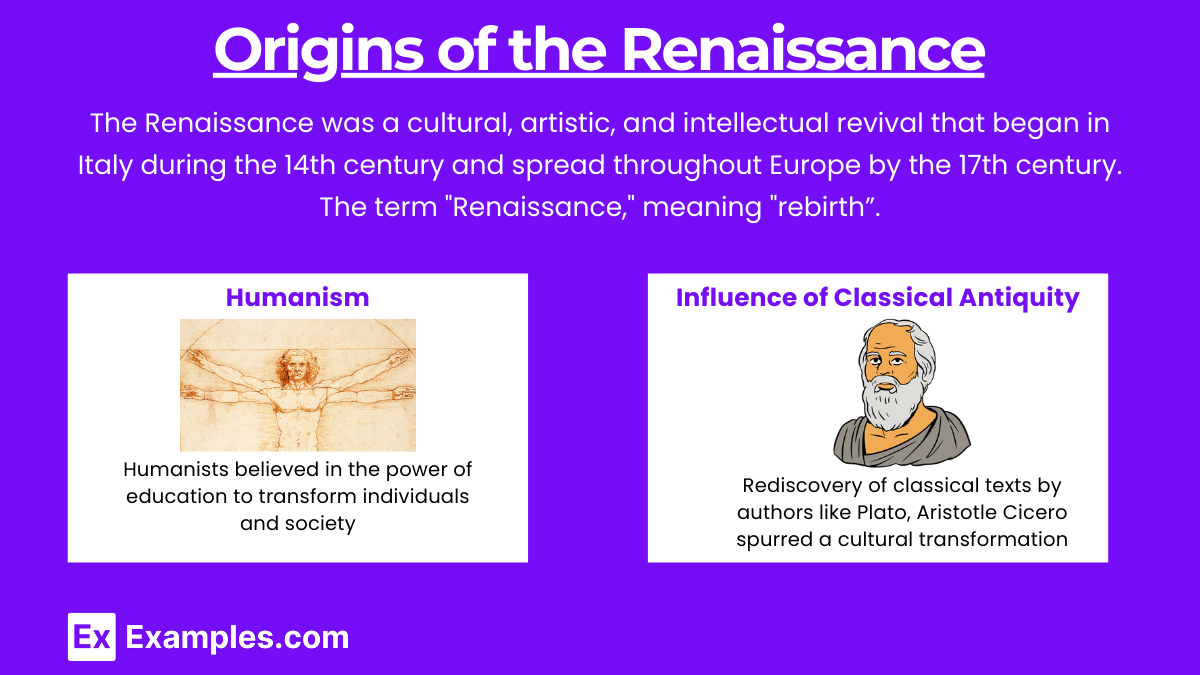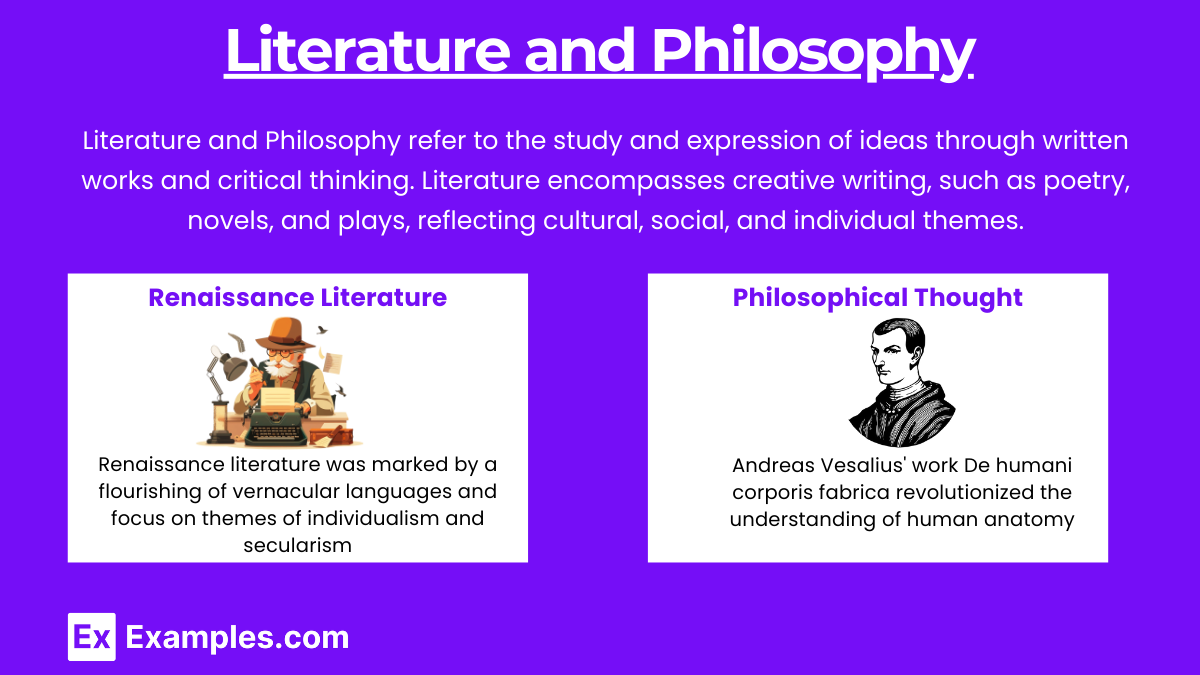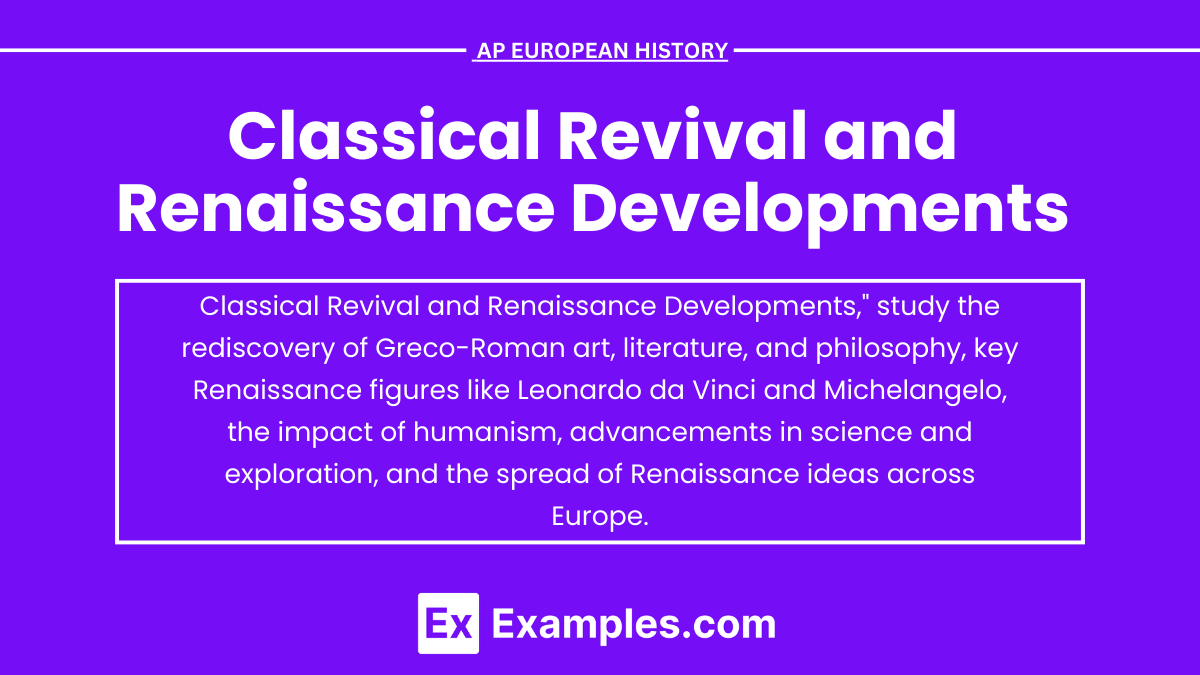The Classical Revival, or Renaissance, marked a cultural rebirth in Europe from the 14th to 17th centuries. It emphasized humanism, reviving classical Greek and Roman art, literature, and thought. Key figures like Leonardo da Vinci and Michelangelo advanced realistic art and anatomical precision, while the scientific method began to take shape. The period also saw political changes with powerful city-states and the influential Medici family. The printing press played a vital role in spreading Renaissance ideas, making knowledge more accessible.
Learning Objectives
For the AP European History exam, focus on understanding the key elements of the Classical Revival and Renaissance developments. Learn about the rise of humanism and its impact on education and society. Study the contributions of major artists, architects, and thinkers, such as Leonardo da Vinci, Michelangelo, and Machiavelli. Understand the scientific advancements, like the heliocentric theory, and the political dynamics, including the role of city-states and the Catholic Church. Recognize the significance of the printing press in disseminating Renaissance ideas.
Origins of the Renaissance

The Renaissance was a cultural, artistic, and intellectual revival that began in Italy during the 14th century and spread throughout Europe by the 17th century. The term "Renaissance," meaning "rebirth," reflects the period's renewed interest in the classical art, literature, and philosophies of ancient Greece and Rome. This era marked a significant departure from the medieval period, characterized by a focus on religious life and scholasticism, towards a new emphasis on human potential and worldly experience.
1. Humanism
Humanism was a central intellectual movement of the Renaissance, emphasizing the study of classical texts and the value of human potential and achievements. Humanists believed in the power of education to transform individuals and society. They studied subjects known as the "studia humanitatis," which included grammar, rhetoric, poetry, history, and moral philosophy.
2. Influence of Classical Antiquity
The rediscovery of classical texts by authors like Plato, Aristotle, and Cicero spurred a cultural transformation. Scholars sought to understand the ancient languages and to translate and interpret these texts, leading to a new educational curriculum that emphasized classical knowledge.
Renaissance Art and Architecture
1. Characteristics of Renaissance Art
Renaissance art was characterized by realism, attention to detail, and a focus on the human form. Artists like Leonardo da Vinci, Michelangelo, and Raphael mastered techniques such as linear perspective, chiaroscuro (the use of strong contrasts between light and dark), and anatomical precision.
Leonardo da Vinci: Known for works like the Mona Lisa and The Last Supper, Leonardo was a polymath who made significant contributions to various fields, including art, science, and engineering.
Michelangelo: His sculptures, such as the David and the Pietà, and his painting of the Sistine Chapel ceiling, showcase his mastery of human anatomy and expressive artistry.
Raphael: Renowned for his frescoes in the Vatican, particularly The School of Athens, Raphael exemplified the harmonious and balanced style of the High Renaissance.
2. Architectural Innovations
Renaissance architecture revived classical Roman elements, such as columns, domes, and arches, integrating them with new techniques. Filippo Brunelleschi's design of the dome for the Florence Cathedral (Duomo) and Leon Battista Alberti's writings on architecture are notable contributions from this period.
Scientific Advancements

Scientific Advancements refer to the progress and discoveries in various scientific fields that significantly expand human knowledge and understanding of the natural world. These advancements often result from the application of the scientific method, involving systematic observation, experimentation, and analysis to develop new theories or improve existing knowledge. During the Renaissance, scientific advancements transformed many disciplines, including astronomy, physics, medicine, and anatomy, leading to groundbreaking changes in how people understood the universe and human health.
1. The Scientific Method
The Renaissance saw the beginnings of the scientific method, characterized by observation, experimentation, and questioning of traditional authorities. Figures like Nicolaus Copernicus, who proposed the heliocentric model of the universe, and Galileo Galilei, who improved the telescope and made significant astronomical observations, were pivotal in this shift.
2. Anatomy and Medicine
Andreas Vesalius' work De humani corporis fabrica revolutionized the understanding of human anatomy, challenging the inaccuracies of ancient texts and laying the groundwork for modern medicine.
Political and Social Developments
1. Renaissance Politics
The political landscape of the Renaissance was marked by the rise of powerful city-states in Italy, such as Florence, Venice, and Milan. The Medici family in Florence, for example, were influential patrons of the arts and played a key role in the political and cultural life of the city.
2. The Role of the Church
The Catholic Church remained a significant influence during the Renaissance. However, the period also witnessed challenges to the Church's authority, such as the early rumblings of the Protestant Reformation and the humanist critiques of clerical corruption.
Literature and Philosophy

Literature and Philosophy refer to the study and expression of ideas through written works and critical thinking. Literature encompasses creative writing, such as poetry, novels, and plays, reflecting cultural, social, and individual themes. Philosophy involves the exploration of fundamental questions about existence, knowledge, ethics, and the nature of reality, often through logical reasoning and systematic argumentation. Together, literature and philosophy provide a deep understanding of human experience and the intellectual currents that shape societies.
1. Renaissance Literature
Renaissance literature was marked by a flourishing of vernacular languages and a focus on themes of individualism and secularism. Dante Alighieri's Divine Comedy, Geoffrey Chaucer's Canterbury Tales, and William Shakespeare's plays are exemplary works from this period.
2. Philosophical Thought
Renaissance philosophy encompassed a wide range of ideas, from the revival of Platonism to the development of political thought. Niccolò Machiavelli's The Prince offered a pragmatic approach to political power, contrasting with the more idealistic views of humanists like Thomas More, author of Utopia.
The Renaissance, a period of profound cultural, artistic, and intellectual transformation, reshaped Europe from the 14th to the 17th centuries. It marked a departure from medieval scholasticism, focusing instead on the rediscovery of classical antiquity and the celebration of human potential. This era fostered the rise of humanism, which emphasized education and the study of classical texts, leading to advancements in art, architecture, and science. Key figures like Leonardo da Vinci, Michelangelo, and Nicolaus Copernicus made groundbreaking contributions that defined the period. The political landscape evolved with the emergence of powerful city-states and influential families like the Medici, while the Catholic Church faced both support and criticism, setting the stage for future religious reforms. The Renaissance's legacy lies in its profound impact on European thought, culture, and society, laying the foundation for the modern world.


